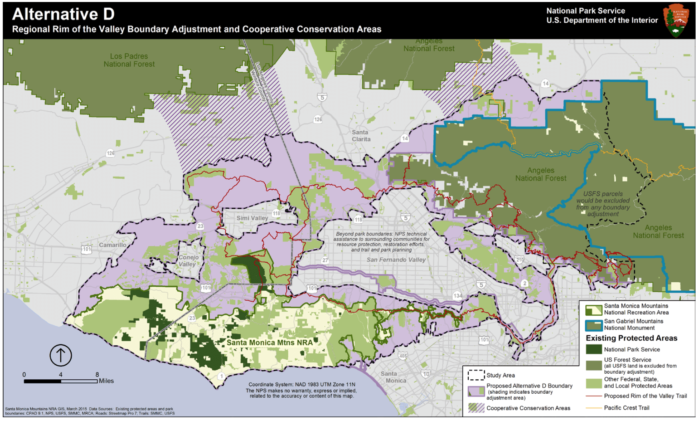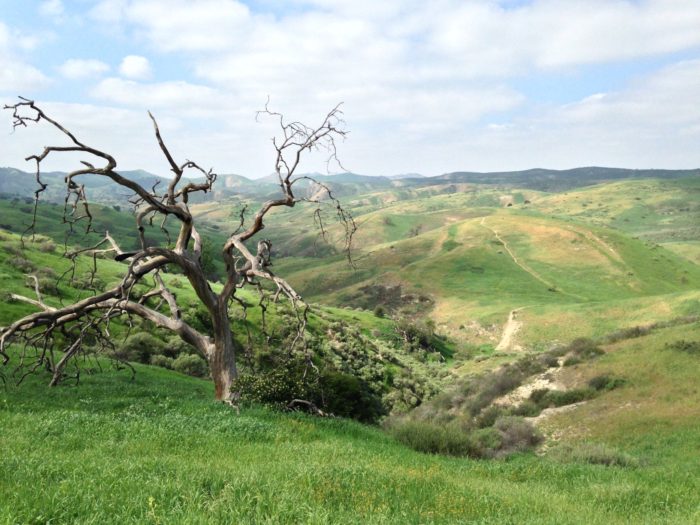At an auditorium inside the Los Angeles Zoo, Congressman Adam Schiff joined the National Park Service’s Project Manager Anne Dove and Santa Monica Mountains National Recreation Area Superintendent David Szymanski spoke to a gathered crowd about the recently completed Rim of the Valley Corridor Study.
The Rim of the Valley Corridor Study is just one step in an ambitious plan to expand the boundaries of the Santa Monica Mountains National Recreation Area into other parts of the Los Angeles region, specifically around the San Fernando Valley (hence the name). We previously did an in-depth synopsis of the different alternatives being put forward by the Park Service during their public comment period last year. If you’re just coming to this project for the first time, we recommend reading that post just to catch yourself up on what’s going on.
After the public comment period ended, Park Service officials compiled the data and made a final recommendation — which in this case ended up being a hybrid of Alternatives C and D from the first study.
New Boundaries
The Selected Alternative adds approximately 170,000 acres of land to the National Recreation Area. The new boundaries excluded several areas under consideration, including broad swaths of the Santa Susana Mountains and portions of the eastern Santa Monica Mountains as well. During her presentation, Dove noted the boundary adjustments were strategic.
[pullquote]”If we’re successful in this,” said Schiff, “it’s not the end.” [/pullquote]Extensive oil and gas infrastructure in the Santa Susanas would have required an immense amount of new resources and expertise from the Park Service, she said. Oil and gas extraction is one of the few industrial uses the NPS is required to manage on land it’s involved with, and incorporating those fields in the Santa Susanas would have increased the amount of regulation the Park Service does in those industries 70% nationwide. Oil and gas wells do still exist in the recommended boundaries, she said, but it is a “significantly smaller” number of leases and they are in more critical habitat and more viable for the Park Service to manage.
Other areas where the boundaries were pulled back included heavily urbanized areas of the eastern Santa Monica Mountains and Hollywood Hills that are already densely residential, as well as areas with active landfills, solid waste facilities, and areas along the Los Angeles River and Arroyo Seco corridors.
However, new land was also added into the boundaries, including significant portions around the Simi Hills, Conejo Valley, and northern Santa Monica Mountains.
The Cost of Expansion
In a slide detailing the cost of each Alternative, Dove pointed out that this Selected Alternative was the most efficient route for expanding the Santa Monica Mountains, capturing the highest percentage of already-protected land at a moderate cost.

Alternative C would have added 173,000 acres of land with 42% of that land already protected, at a cost of $900,000 to 1.9 million additional annual budget. Alternative D, which was favored by 90% of the 1,800 public comments received last year, would have added 313,000 acres. Only 23% of that land is already protected, and the annual cost of that Alternative would have added $1.4 to 3.4 million per year.
The Selected Alternative is the same cost as Alternative C and adds 170,000 acres with 48% already protected.
Opening the Toolbox
One of the primary benefits of this Selected Alternative is the inclusion of the Cooperative Conservation Partnership abilities from Alternative B. This authorizes the National Park Service to assist with cooperative planning and funding tools for partner agencies and individual landowners throughout the Rim of the Valley Study Corridor, as well as helping with larger-scale projects like wildlife crossings.
Inside the boundaries, the Park Service can use funds for “resource protection, visitor services, land acquisition, and the planning and development of visitor facilities such as trails and waysides,” meaning some long-neglected areas like Griffith Park or Rustic Canyon Park might finally get some of the love and attention they deserve.
Outside the NRA’s boundaries, the Park Service can still offer extensive technical assistance, including guidance on “natural resource protection and restoration … protection of regional wildlife corridors and adjacent tributaries, trail and park planning, and (bringing) agencies, organizations, and landowners together to achieve common goals.” In other words, they can help organize disparate groups toward a singular goal, provide valuable research data to groups throughout the region, and even assist with trail the routing and interpretive elements of trails.
That Old ‘Land Grab’ Chestnut
As is often the case with new federal land designations, residents and local landowners are concerned about losing their private property rights. It is a sentiment we saw extensively with the run up to the San Gabriel Mountains National Monument and a notable portion of comments from the Q&A session of this meeting had to do with that issue as well. Would the NPS seize land? Would they limit the activities on private land within and outside the new boundaries?

Many citizens wanted access to a Google Maps layer that could show them exactly where the proposed boundaries lay, and both Schiff and the Park Service staff said they were working on such a tool but that it may be a while before it’s available to the public. Superintendent Szymanski addressed the land-grab and use-restriction ideas directly, saying “The Park Service is a land management agency, not a regulatory agency … All planning and zoning decisions will remain at the local level, and we only have regulatory power over land we own directly,” (currently only about 15% of the existing NRA).
Congressman Schiff echoed that sentiment, saying the Park Service gets no explicit property rights within the boundaries. The Park Service does not have eminent domain rights and the proposal explicitly states that the Park Service may only acquire new land from willing parties, with condemnation available as a last-resort. The Park Service does have the ability to comment on proposed projects outside of its boundaries that may affect watersheds and wildlife corridors, but it is limited to commenting only. This authority already exists within the Santa Monica Mountains Zone, established in 1978.
Basically, if you’re not interested in donating or selling your land to the Park Service, you don’t have to worry about losing it.
Citizen Concerns
Most of the people who attended the meeting were supportive of the Rim of the Valley plans, and most of those who expressed concerns and criticisms did go out of their way to thank the Congressman and the Park Service for their efforts on this project. Many of the concerns about the Alternative had to do with individual properties, but there were also broader regional concerns — along with some residual frustration about the areas excluded from the San Gabriel Mountains National Monument.
There was much talk of watersheds, specifically worries about an insufficient level of protection for the Arroyo Seco and the Eastern San Fernando Valley near Sunland-Tujunga. Many who had pushed for Alternative D wanted more land included in the new NRA, up to and including the heavily-used swaths of the front range of the San Gabriels in the Angeles National Forest that were confusingly excluded from the new National Monument. There was also concern about the California High Speed Rail, which is investigating a route tunneling under the San Gabriels that may be disruptive to both wildlife and the regional watershed.

The expansive Alternative D
Schiff responded to those concerned about reduced boundaries by saying he also wanted the broader Alternative D, but that he had to figure out what he could realistically get passed through a Republican Congress. Although he has yet to officially introduce legislation on the Rim of the Valley, he is concerned that the larger boundaries and price tag of Alternative D would face steeper opposition from Congress.
There was also a sizable group calling for Schiff to work with Congresswoman Judy Chu to establish a new wilderness designation centered on Condor Peak, which is currently in the Angeles National Forest and outside the scope of the Rim of the Valley Study Area. The group cited local demand for more wilderness areas and noted Republican Congressman Steve Knight’s legislation to preserve close to 70,000 acres in the Santa Clarita Valley as the Castaic Wilderness.
To this, Schiff replied, “I have a very short answer to that: Amen.”
Wildlife crossings and corridors were much-discussed topics as well. The planned Liberty Canyon overpass received high praise and many who spoke wanted similar structures to connect the mountain ranges surrounding the San Fernando Valley for wildlife. Szymanski and Dove were enthusiastic about increased wildlife corridors, but clarified that support for those projects usually comes from local partner groups raising funds and political will. Being near the Rim of the Valley Study Area, however, would make it easier for the Park Service to offer information and expertise in such projects, like tracking data from collared mountain lions.
A Work in Progress
All of the parties involved went out of their way to highlight that this was a work in progress. Now that the study is completed, the Congressman has to introduce specific legislation in Congress, which he said he was planning on doing within the next few weeks. Once that legislation is introduced, it can be amended and altered, and even then the battle isn’t done.

“If we’re successful in this,” said Schiff, “it’s not the end.” Every year there’s a fight about resources for land management in the federal budget, and “a project like this will require a sustained multi-generational effort” to be successful.
Szymanski echoed this sentiment — a sentiment we at Modern Hiker have been very vocal about as well — by saying it is up to the citizens of the community to ensure any park project is successful. Since the Park Service can’t directly involve itself in politics, it is up to the people who use and enjoy these places to write their representatives to ask for adequate funding, and to form and get involved with local partner groups to supplement federal budgets and efforts.
“Getting anything passed through Congress is difficult,” Schiff said in his closing remarks, “but I’m intent on getting the job done.”

